文中代码基于Python3.7
MRO规则可以总结为以下三句话:
-
In the multiple inheritance scenario, any specified attribute is searched first in the current class. If not found, the search continues into parent classes in depth-first, left-right fashion without searching the same class twice.
-
So, first it goes to super class (and its super classes) given first in the list then second super class (and its super classes) , from left to right order. Then finally Object class, which is a super class for all classes.
这里的list指的是多个父类组成的list,如:
class M(X,Y,Z):
pass
list就是(X,Y,Z)
-
When in MRO we have a super class before subclass then it must be removed from that position in MRO.
这一句和第一句对应起来看,一个类只被检索一次,所以基类要往后移
可以调用类型对象的mro方法或者__mro__属性来获取类型的MRO信息。
class X: def hello(self): print('x') class Y: def hello(self): print('y') def world(self): print('y_world') class Z: def hello(self): print('z') class A(X): def hello(self): print('a') class B(Y,Z): def hello(self): print('b') class M(B, A): pass print(M.mro()) print(M.__mro__) # 输出: # list类型 [<class '__main__.M'>, <class '__main__.B'>, <class '__main__.Y'>, <class '__main__.Z'>, <class '__main__.A'>, <class '__main__.X'>, <class 'object'>] # tuple类型 (<class '__main__.M'>, <class '__main__.B'>, <class '__main__.Y'>, <class '__main__.Z'>, <class '__main__.A'>, <class '__main__.X'>, <class 'object'>)
MRO图示如下:
goes to super class (and its super classes) given first in the list then second super class (and its super classes) , from left to right order. Then finally Object class
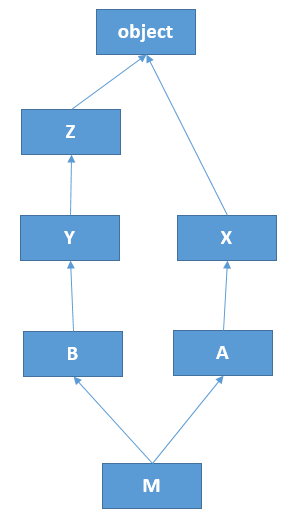
depth-first, left-right fashion without searching the same class twice ,得到MRO列表:[<class '__main__.M'>, <class '__main__.B'>, <class '__main__.Y'>, <class '__main__.Z'>, <class '__main__.A'>, <class '__main__.X'>, <class 'object'>]
B和A均继承自Z,M继承自B和A:
class X: def hello(self): print('x') class Y: def hello(self): print('y') def world(self): print('y_world') class Z: def hello(self): print('z') class A(X,Z): def hello(self): print('a') class B(Y,Z): def hello(self): print('b') class M(B, A): pass print(M.mro()) # 输出: # [<class '__main__.M'>, <class '__main__.B'>, <class '__main__.Y'>, <class '__main__.A'>, <class '__main__.X'>, <class '__main__.Z'>, <class 'object'>]
MRO图示如下:
goes to super class (and its super classes) given first in the list then second super class (and its super classes) , from left to right order. Then finally Object class
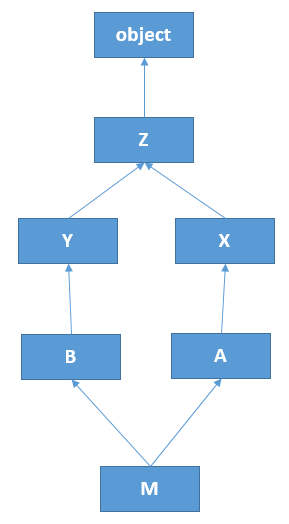
depth-first, left-right fashion without searching the same class twice ,得到MRO列表:[<class '__main__.M'>, <class '__main__.B'>, <class '__main__.Y'>, <class '__main__.A'>, <class '__main__.X'>, <class '__main__.Z'>, <class 'object'>]
class X: def hello(self): print('x') class Y: def hello(self): print('y') def world(self): print('y_world') class Z: def hello(self): print('z') class A(X,Z): def hello(self): print('a') class B(Y,Z): def hello(self): print('b') class M(B, A, Y): pass print(M.mro()) # 输出 # [<class '__main__.M'>, <class '__main__.B'>, <class '__main__.A'>, <class '__main__.Y'>, <class '__main__.X'>, <class '__main__.Z'>, <class 'object'>]
MRO图示如下:
goes to super class (and its super classes) given first in the list then second super class (and its super classes) , from left to right order. Then finally Object class
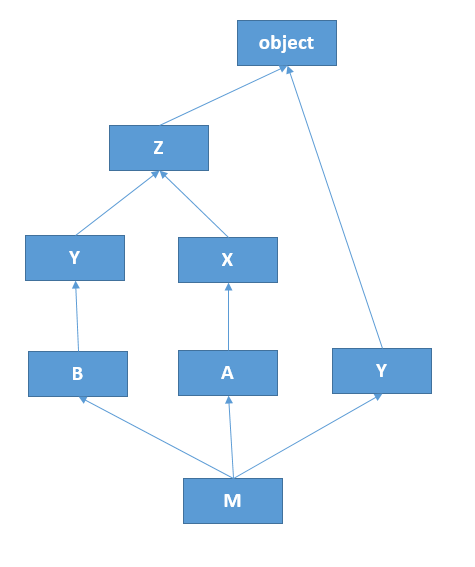
这个MRO图可以继续简化:
depth-first, left-right fashion without searching the same class twice
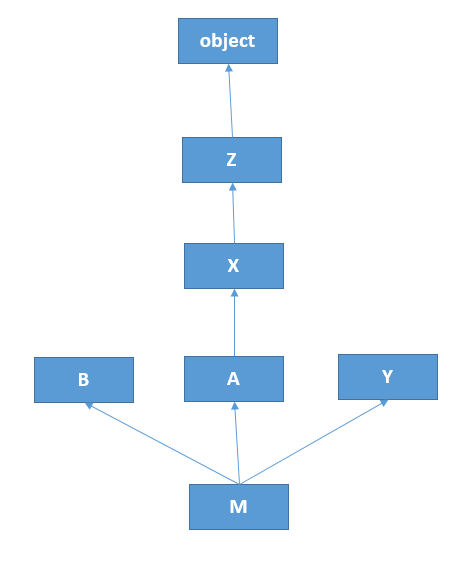
得到MRO列表为[<class '__main__.M'>, <class '__main__.B'>, <class '__main__.A'>, <class '__main__.Y'>, <class '__main__.X'>, <class '__main__.Z'>, <class 'object'>]
When in MRO we have a super class before subclass then it must be removed from that position in MRO
下面是一个会报错的示例:
class A: def process(self): print('A process()') class B(A): def process(self): print('B process()') class M(A, B): pass print(M.mro()) # 输出: # TypeError: Cannot create a consistent method resolution # order (MRO) for bases A, B
MRO图示:
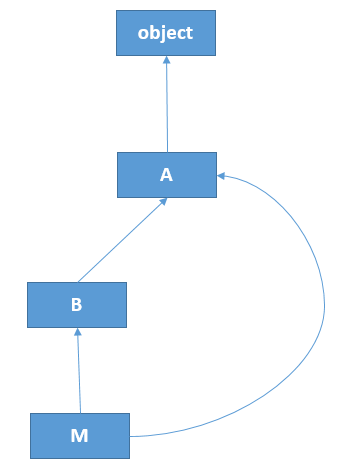
如果一个方法或属性同时存在与B和A,应为M直接继承B又直接继承A,那么通过M来调用时就不知道是该从B中还是A中获取这个方法或属性了,干脆就报错吧。我觉得MRO顺序应该为:M->B->A->object。